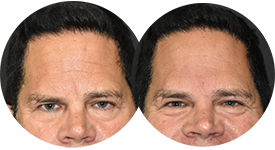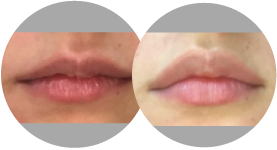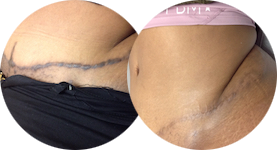PRP for Hair Loss
Conveniently located to serve the areas of Rancho Cucamonga, CA
Platelet-rich plasma (PRP) for hair loss is a safe and effective treatment to help patients reclaim texture and fullness in thinning or balding hair by using their body’s own restorative properties. With age, our hairline recedes, bald spots expand, and our hair loses its overall youthful appearance. While hair loss is a common condition for most people, it can still seriously affect self-confidence and self-image. Traditional hair loss treatments utilize rather extensive surgical methods to relocate healthy follicles to balding areas, leaving behind permanent, noticeable scarring after the patient has healed. Other less invasive methods like topical agents or creams only restore natural hair to a fraction of the patient’s desired results. With both of these approaches, the patient is left with unwanted side effects or less than desirable results. However, by using the patient’s organic PRP, Dr. Patricia Guevara-Channell can restore damaged or atrophied hair follicles, giving them the power to regrow thicker, fuller hair.
If you are experiencing hair loss and would like to see genuine results without the hassle of surgeries or the underwhelming results of hair loss creams, please schedule a consultation at our Rancho Cucamonga offices. Here, the experts at Channell Wellness & Aesthetics will learn about your cosmetic concerns on a personal level and create a personalized treatment plan to have you looking and feeling your best! To reach our friendly front desk staff, don’t hesitate to call us at (909) 483-1236.
Contents
About Androgenetic Alopecia
While there are different forms of alopecia that result in hair loss around the head and body, androgenetic alopecia is the most common, affecting 50% of women and 80% of men.[1] This condition is brought on by dihydrotestosterone affecting androgen-sensitive hair follicles. Because testosterone plays such an important role in androgenetic alopecia, men can experience hair loss at earlier ages than women. In fact, 25% of the men who experience hair loss see hair thinning by the time they’re 21.[2] Most women, however, see hair loss progress through and after menopause, when hormones are imbalanced, and testosterone levels may be irregularly high. Androgenetic alopecia causes a gradual reduction in hair follicle length, color, and thickness. For women, this process occurs around the crown of their heads. For men, this process can affect the entire top of the head, as a receding hairline worsens with age and bald patches exist everywhere but the back and sides of the head. While there is no cure for androgenetic alopecia, the answer for an effective treatment that yields genuine results might reside in our bodies, coursing through our veins.
The Restorative Science of PRP
Under our skin, right now, is an intricate system of restorative proteins and chemicals that our body readily makes to employ at a moment’s notice. Whether it’s a scraped knee or a nick from shaving, the body and brain work in sync to send a complex blend of properties to the wounded area through our bloodstream. This blend repairs tissue, generates new tissue, if needed, and heals the wound. Just under half of these cells are red blood cells. They exchange oxygen for carbon dioxide to the neighboring cells and tissue, carrying the carbon dioxide to be processed through the respiratory system. Plasma contains proteins, hormones, glucose, and restorative ions and gasses, makes up just under half of the blood’s composition as well. Plasma acts as a vessel for the body to send restorative properties from one area to another.[3]
Plasma and red blood cells each make up just under half of the blood’s composition. Platelets, and white blood cells round out the last 2%. While small in numbers, these cells pack most of the restorative punch in this blend of complex properties. White blood cells contain neutrophils and macrophages which are cells that destroy foreign bodies, bacteria, debris, and viruses. This is why white blood cell count is important for fighting off sicknesses. Platelets carry a cell called megakaryocytes: a cell essential for repairing damaged tissue and clotting the wound to stop blood loss. Working in tandem, platelets and white blood cells disperse growth factors around the wound to generate new tissue in the damaged areas. While this process happens to the skin on a surface level, platelets and white blood cells also repair internal tissue damage like ligament or muscle tears.
So, What Is The Science Behind PRP for Hair Loss?
By separating the platelets, white blood cells, and plasma from a patient’s blood, we can intentionally direct these restorative properties to damaged hair follicles. Once in place, the PRP cells simply follow their intrinsic code: heal and restore cells to their natural state. For a patient experiencing hair loss, this means fuller, longer, and more vibrant hair.
Why Choose PRP
While other hair loss treatments promise reliably natural-looking results, they do so at the cost of extensive surgeries or disheartening results. However, with PRP, patients receive genuine hair regrowth and avoid those two common pitfalls.
No Scarring
Other forms of hair loss treatment like follicular unit transplantation (FUT) begin with a long incision across the back of the head. For most people with androgenetic alopecia, the back of the head doesn’t experience any hair loss and is plentiful in healthy hair follicles. Through this incision, these healthy follicles are extracted and readied for insertion into balding areas. After an arduous, and quite painful, procedure, the patient does see natural, genuine results. However, these results come at the cost of a long, oftentimes conspicuous, scar. Even with long hairstyles, this scar is seen. But, with PRP, no incisions are necessary! The PRP serum is simply applied through micro-channels in the scalp, so the restorative properties can seep into the hair follicles.
Natural Results
Because PRP uses the patient’s own natural properties, they can expect natural results devoid of any adverse reactions. Hair loss treatments like wigs, toupees, and non-organic hair loss cover-ups appear unnatural or unconvincing to pass off as real hair. For those who have routinely turned to these expensive and unsuccessful hair loss treatments, the ease and effectiveness of PRP might just be for you!
Enhanced Thickness and Hair Growth
By administering PRP to patients and studying their follicular response, researchers have deduced that this approach can yield promising results for those interested in naturally regrowing their hair.[4] The density, length, and pigmentation of the hair have been seen to grow and improve in the days following a PRP for hair loss treatment.
For those interested, the first step is to schedule a personal consultation at our Rancho Cucamonga offices.
Personal Consultation
If this is your initial consultation, we will begin with a brief new patient intake interview and a physical examination. Then, we will listen to your hair loss experience. Typically, patients start to notice loose hair on their pillow when they wake up, see more strands fall out in the shower than usual, or spot their hair looking thin or wiry in pictures or the mirror. For most, hair loss is a gradual process that increases with age. If you experienced sudden, drastic hair loss, this might be another, more aggressive form of alopecia and might not benefit from PRP. At the end of your consultation, we will note any other cosmetic concerns. PRP is a simple, non-surgical procedure that complements other rejuvenation treatments. Commonly, other PRP treatments are popular among clients as well as hormone therapy for both men and women. As hair loss is intrinsically related to age, so too is hormone imbalance, and, like hair loss, the best way to treat it effectively is to catch it early.
Preparation
Since PRP therapy for hair loss is not a surgical procedure, you will not have to prepare extensively – unlike other hair loss treatments. First, be sure to come to our offices without any product in your hair. Second, drink plenty of water before and after your procedure. And third, avoid any blood-thinning medications and nicotine products as these affect your circulatory system and may lead to diminished results.
Procedure
We begin all PRP treatments by extracting a small vial of the patient’s blood. Then, we run this sample through a centrifuge. At these high speeds, the blood cells separate as the oxygen and carbon dioxide in the red blood cells are denser and heavier than the white blood cells, platelets, and plasma. Once separated, the red blood cells rest at the bottom of the vial while the other, lighter-toned components rest at the top. The above layer is called the “buffy coat” and is the prime ingredient in the patient’s PRP serum. We then take the PRP serum and inject it into the patient’s balding or thinning areas. By focusing the PRP serum on the roots, the restorative properties don’t have far to travel to begin repairing damaged cells. Over the next few days and weeks, patients can expect to see natural hair growth that is thicker, fuller, and more vibrant in the treated areas.
How Much Does PRP For Hair Loss Cost In Rancho Cucamonga?
The cost of a PRP treatment will depend on the size of the treated area(s) and the number of sessions a patient requires to see their desired results. While hair loss is common, the degree of hair loss is individual, so the requirements for each hair restorative treatment will vary, thus affecting the price. If you would like to learn more about our pricing, call our front desk at (909) 483-1236. If you like staying up-to-date on all things Channell Wellness and Aesthetics, be sure to keep an eye out for our latest specials!
How Much Does PRP For Hair Loss Cost In Rancho Cucamonga?
The cost of a PRP treatment will depend on the size of the treated area(s) and the number of sessions a patient requires to see their desired results. While hair loss is common, the degree of hair loss is individual, so the requirements for each hair restorative treatment will vary, thus affecting the price. If you would like to learn more about our pricing, call our front desk at (909) 483-1236. If you like staying up-to-date on all things Channell Wellness and Aesthetics, be sure to keep an eye out for our latest specials!
References
- Piraccini BM;Alessandrini A. (2014). Androgenetic alopecia. Giornale Italiano Di Dermatologia E Venereologia : Organo Ufficiale, Societa Italiana Di Dermatologia E Sifilografia, 149(1). https://pubmed.ncbi.nlm.nih.gov/24566563/
- American Hair Loss Association – Men’s Hair Loss / Introduction. (2021). Americanhairloss.org. https://www.americanhairloss.org/men_hair_loss/introduction.html
- CK-12 Foundation. (2021). Welcome to CK-12 Foundation | CK-12 Foundation. CK-12 Foundation; CK-12 Foundation. https://www.ck12.org/book/ck-12-biology-advanced-concepts/section/17.44/
- Stevens, J., & Khetarpal, S. (2018). Platelet-rich plasma for androgenetic alopecia: A review of the literature and proposed treatment protocol. International journal of women’s dermatology, 5(1), 46–51. https://doi.org/10.1016/j.ijwd.2018.08.004






